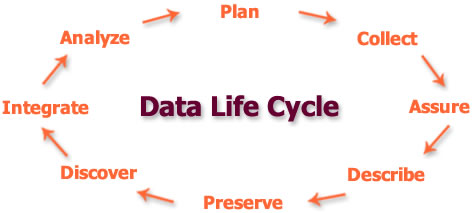Obviously, the foremost reason for needing a plan is that agencies such as the NSF, the National Institute of Health (NIH), and the National Endowment for the Humanities (NEH) are requiring DMPs. Hear what Dr. Stephenson has to say about the impact of DMPs on choosing which grants to fund.
There are other reasons, however, why formulating a plan for managing research data is important.
Reason One:
First, a DMP helps you plan and organize your data collection by having you think through the questions that will arise as you gather data. A DMP essentially documents key activities in the research data lifecycle, such as the collection, description, preservation, and access or discovery of data. Such documentation is crucial to reproducibility of research results which is a fundamental precept of scientific investigations.
By laying out the blueprint for lifecycle management of data, a DMP provides valuable details, such as how the data will be preserved for the long term, how and where the researcher will make the data available for sharing, and whether reuse of the data, including derivatives, will be allowed.
Reason Two:
Second, related to reproducibility, a DMP can help prevent or reduce the likelihood of mishaps such as data loss, data errors, and unethical uses of data. In effect, a DMP fosters improved communication and accountability for data.
Reason Three:
Third, data that has been generated by a federally funded project is publicly funded data - that is, data that has been made possible by taxpayer dollars. As such, unless there are restrictions or sensitivities about the data, these are data that should be made available to the public for broad sharing and accessibility.
Finally, having a DMP reflects an understanding that the collected data have intrinsic value, as illustrated in the video below. It can be another source of attribution and further investigations. Indeed, as described by Dr. Alfred Traverse, Curator of the Penn State Herbarium, in the following video, sometimes the collected data is all that remains for further investigations.



